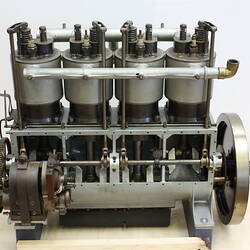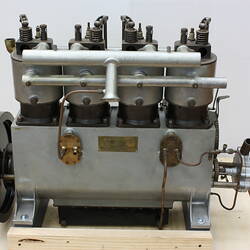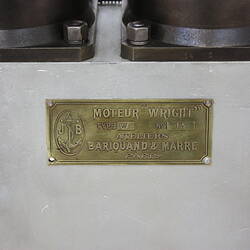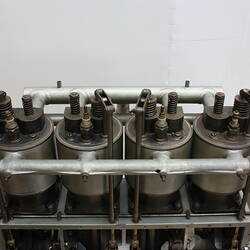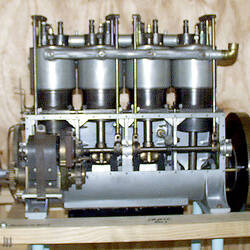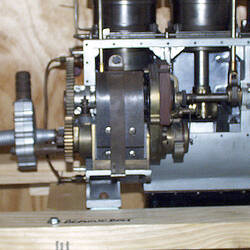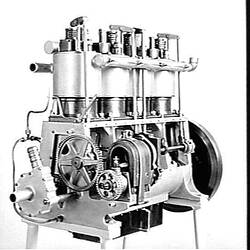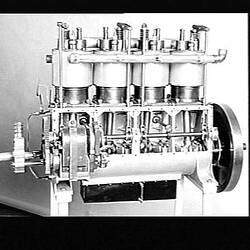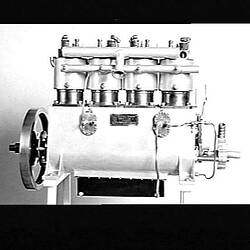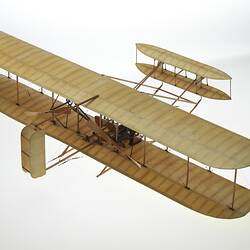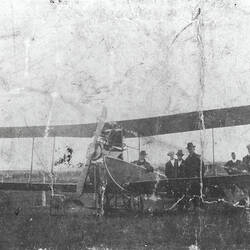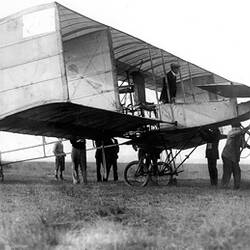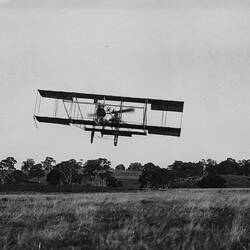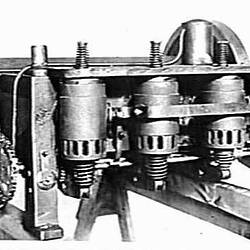Summary
This four-cylinder vertical water-cooled aero engine was designed by Orville Wright in about 1906 and built under licence by the engineering firm Bariquand et Marré in Paris in about 1908-09. It carries the manufacturer's serial no.14. Bariquand & Marre modified the valve and cam design from the Wright original which did not please Wilbur Wright who supervised the preparation of the engine for production in France. He wrote in his diary on 9 June 1908 that "We went to Bariquand's but of course nothing was ready. I fear they will have the old motor ruined before I can get it out of their hands. They are such idiots! and fool with things that should be left alone". The Wright engine was also licence-built in Germany by Neue Automobil-Gesellschaft and by the Wright Brothers own company in the United States of America.
This is the engine from the only Wright biplane imported into Australia. The Wright Model 'A' aircraft was imported by Mr Lawrence Arthur Adamson from Europe in October 1909. Adamson was then the headmaster of Wesley College, Melbourne. Together with a Bleriot monoplane also purchased by Adamson, this Wright Model 'A' was the first powered aircraft imported into Australia. Named 'The Stella', it was used by Colin Defries to achieve the first powered flight in Australia. Defries tried to become airborne in three attempts at Victoria Park Racecourse, Sydney, on 4 December 1909 but the engine failed to develop full power and the machine was damaged. A brief straight-line flight of about 115 yards (105 m) at a height of between 2 and 15 feet (0.61 to 4.5 m) was apparently achieved by Defries at the same location on 9 December 1909. This was the first flight of a manned, heavier-than-air, powered aircraft in Australia, however there is some dispute about whether it was in fact 'controlled flight'. The Australian Aerial League did not classify this attempt as a 'controlled flight'. In March 1910, the Wright biplane was used again at Digger's Rest in Victoria by Ralph Conningsby Banks. He was reported to have achieved an uncontrolled flight of around 300 yards (274 m) at a height of 15 feet (4.57 m) before crashing. Just two weeks later, Harry Houdini (a.k.a Ehrich Weiss) flew a Voisin biplane at the same location to achieve the first recognized 'controlled flight' in Australia.The Wright Model 'A' biplane was repaired but not used again. The engine was removed and the aircraft (along with the Bleriot) was dumped at sea later in 1910 to enable Adamson to obtain a refund of the customs import duty of £798.
This engine was donated to the Museum in 1975 after spending a long period in a Geelong garage. It is the same engine installed in a biplane flown in Geelong by Danish-born Hans Christian Andersen. Andersen, a Geelong garage proprietor, purchased this machine from John R. Duigan who built the biplane based on an Avro design at Ivanhoe in 1912-13 but crashed it on its first flight in February 1913 and then sold it to Andersen in 1915. Duigan kept the original ENV engine and Andersen obtained the Bariquand & Marre Wright engine to use in the rebuilt machine. The Museum also holds one of the two propellors fitted to Adamson's Wright biplane.
Physical Description
Engine Type: 4-cylinder single-stroke verical inline Model: Type W Serial Number: 14 Bore x Stroke: 112 mm x 111 mm Displacement: 4,372 c.c. Compression Ratio: 4.165 Rated Power Output: 30 B.H.P. at 1,300 r.p.m. Weight: 160-180 lbs (72-82 kg)
More Information
-
Collecting Areas
-
Acquisition Information
Donation from Mrs P. Tucker, Jun 1975
-
Manufacturer
-
Designer
Mr Orville Wright, Dayton, Ohio, United States of America, 1906
-
Past Owner
L. A. Adamson, Melbourne, Greater Melbourne, Victoria, Australia, 1909
-
Organiser of Event
J.& N. Tait, Concert & Theatrical Promoters, 1909-1910
Concert promotors J.& N. Tait were commissioned by Adamson to tour the Wright biplane around Australia and arranged ticketed public viewings of the plane in the Sydney Town Hall and at the Melbourne Motor Garage. They also toured the Bleriot biplane imported by Adamson. -
Inscriptions
Makers brass plate: 'MOTEUR "WRIGHT" TYPE W No. 14 ATELIERS BARIQUAND & MARREE PARIS' With logo/trademark on left consisting of the initials 'J' and 'B' on either side of an anchor with rope twisted around stem.
-
Model Name or Number
-
Classification
Air transport, Aero engines, Reciprocating propeller engines
-
Category
-
Discipline
-
Type of item
-
Overall Dimensions
1050 mm (Length), 660 mm (Width), 1350 mm (Height), 82 kg (Weight)
Weight estimated as 160-180 lbs. (Smithsonian Annals of Flight, No.5, p.62). Weight previously listed as approx 230 kg, which probably includes stand.
-
Dimensions
105 cm (Length), 66 cm (Width), 135 cm (Height)
Measurement From Conservation. Measuring Method: metal measuring tape
-
Dimensions
890 (Length), 884 (Width), 245 (Height)
Measurement From Conservation.
-
References
Anderson, John D. Jr, The Airplane - A History of Its Technology, American Institute of Aeronautics & Astronautics, 2002. Hobbs, Leonard S., "The Wright Brothers' Engines And Their Design", Smithsonian Annals of Flight, No.5, Smithsonian Institution Press, Washington, 1971. Geelong Advertiser, 27 Feb 1960, "Geelong's Most Historic Aero Engine A Link With Wilbur And Orville Wright".
-
Keywords

